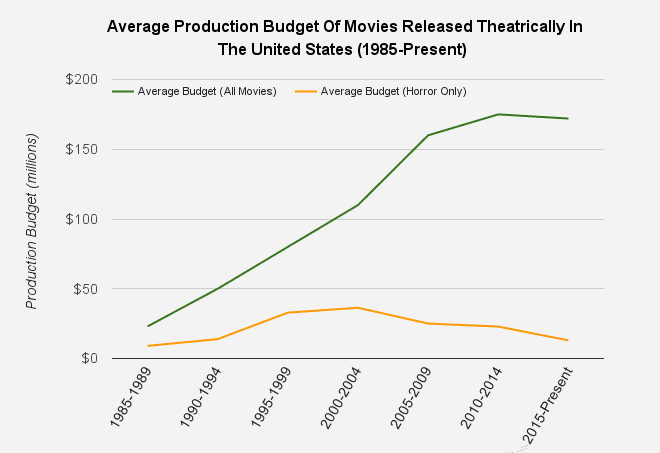Move budgets have increased dramatically over recent years far outpacing inflation. In 1980, the average budget of the 30 highest grossing films in the United States was $20 million. In 2015, the average budget had exploded to a massive $170 million. This represents an average increase of 20% per year in the cost of producing a movie compared to an inflation rate of 3% over the same period.
Interestingly, the increase in budgets has not been uniform across all movie genres. Horror movie production budgets in particular have lagged behind as can be seen from the graph below.

The average horror movie budget is calculated from the 20 most popular horror movies in each five year period. The full data used to perform this calculation is available here.
Surprisingly, the average budget of horror movies has actually decreased in recent years from a peak of $36 million in 2000-2005 to just $13 million from 2015 to present. After adjusting for inflation, recently released horror movies have a budget 35% lower than those released between 1985 and 1989 and 70% lower than those released between 1995 and 1999.
Several factors are likely behind the decline in horror movie budgets. One reason is that studios are simply unwilling to take the risk with big budget horror movies these days, particularly after a string of big budget box office bombs in the late 90s and 2000s including The Haunting (1999) – $180M worldwide gross vs $80M budget, Hollow Man (2000) – $190M worldwide vs $90M budget, Exorcist: The Beginning – $44M worldwide vs $78M budget, and more recently The Wolfman (2010) – $150M worldwide vs $140M budget (films typically need a worldwide gross of 2.5x budget to break even). In recent times, studios have been much more cautious about green-lighting horror films with budgets in excess of $50M, particularly when they are not based on existing IP. Guillermo del Toro for example struggled to get funding for Crimson Peak due to the relatively high budget of $55 million for an original horror film. As it turned out the film was only able to gross $75 million worldwide and made a small loss.
The increase in popularity of found-footage style films has also contributed to the decrease in horror movie budgets as these movies normally have low production costs. The success of The Blair Witch project in 1999, a movie that made $250 million on a cost of just $60,000, spawned a large number of similar found footage style films in the 2000s and 2010s. Between 2005 and 2015, 26 found footage films were released theatrically in the United States with an average budget of just $4 million.
Finally, the rise of the movie production company Blumhouse has also contributed to the rise of so called “micro-budget” horror movies. The Blumhouse model revolves around keeping production costs low by hiring lesser known actors and paying them a cut of box office receipts in exchange for a smaller base pay rate. Blumhouse had their first hit in 2009 with Paranormal Activity ($190 million box office vs $50,000 budget), and have since gone on to produce more than a third of all horror movies since 2010 that have had a wide theatrical release in the USA. Blumhouse’s slate includes: The Purge, Sinister, and Paranormal Activity franchises, along with The Bay, Dark Skies, Oculus, Ouija, Jessabelle, Unfriended, The Gallows, The Lazarus Effect, The Visit, and The Darkness.
A characteristic of these micro-budget movies is that most receive poor or mixed reviews and show significant drop offs in box-office receipts after the opening weekend. Even so, most of these remain highly profitable for example Ouija (C cinemascore, 7% rotten tomatoes) grossed $50 million domestically (40% of that on opening weekend) and The Devil Inside (F cinemascore, 6% rotten tomatoes) grossed $53 million domestically (more than 60% of this on opening weekend). With budgets of $1 million and $5 million respectively, both her highly profitable within a couple of days of release and even though audiences dropped off substantially after opening weekend they were still highly successful. Studios have little incentive to spend more money creating a quality horror product when these low budget, low quality movies are profitable anyway.